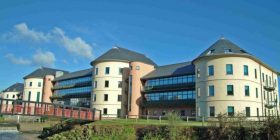Windfarms and illegal off-roading among threats to Blaenavon World Heritage status

Windfarms, rain, illegal off-roading, and declining numbers of farmers grazing sheep have all been identified as risks to Blaenavon’s internationally recognised World Heritage status.
Blaenavon and its surrounding area was granted World Heritage Site status by United Nations cultural body UNESCO in 2000 in recognition of its international importance as the world’s major producer of iron and coal in the late 18th and the early 19th century.
The status recognises the preserved sites of Blaenavon Ironworks and the Big Pit mining museum, as well as a primitive railway system and workers’ houses and the social infrastructure as contributing to the area’s Outstanding Universal Value (OUV).
The Blaenavon World Heritage Partnership has had to review the site to ensure it still meets the OUV standard.
In 2021 Liverpool become only the third location to be stripped of the World Heritage status. The city’s waterfront held the status but new developments, including the new football stadium, now under construction, for English Premier League side Everton, were considered to threaten its unique qualities.
A report, presented to Torfaen Borough Council’s cabinet, said as part of the review of the status a 300 question questionnaire had to be completed – and it had been concluded the OUV of the Blaenavon site has been maintained and remains intact.
But it found eight, of 82 factors that could negatively affect the status, are considered current or potential risks. Five, of those eight, were identified as relevant at the last review in 2013.
The report said the potential impact of renewable energy facilities, such as wind turbines, has increased from “minor” to “significant” during the 10-year period, with a number of large scale wind farms, termed as Developments of National Significance, currently proposed close to the site boundary.
The report warns: “There is the potential for cumulative visual impact on the upland area of the World Heritage Site which may negatively impact upon the attributes which convey OUV.”
It says the world heritage partnership will try to minimise any negative visual impact through the planning system but the risk is out of its control.
Landscape crime, such as illegal off-roading, is also reported as having increased since the last review, while the risk of arson and fires in upland areas is a further risk.
A Gwent Police officer is due to be seconded to work with Torfaen and other local councils to address off-roading, funded from the UK Government’s Shared Prosperity Fund, while land management, such as creating fire breaks, are intended to manage the risk of wildfires.
Land management is also intended to address the risk of bracken in the uplands, which is described as a “hyper-abundant species”.
But a decline in the number of commoners using the uplands for grazing sheep, which contributes to the management of the landscape and maintaining its open character, is one of the three new risks identified.
The report says the risk from declining numbers of commoners is “extensive” and “significant” but says the trend is “static” and they are supported through a management group and funding for land management from the ‘Dragons Teeth’ micro-hydro scheme.
Linked to the decline is the risk from changes in traditional ways of life and the loss of knowledge systems and land management practices. It says while long term management plans are in place to address this further resources are required to fully implement them.
The third new risk identified is ground water pollution due to an adverse impact on ferrous structures of materials laid to the lower yard of Blaenavon Ironworks.
Remedial works to remove the material is planned by heritage body Cadw in 2023/24. The impact is considered to be “insignificant” given the “restricted” area affected and the risk can be removed once the work is completed.
Rainfall is also a risk to the area’s scheduled monuments but these are monitored and work to improve drainage is ongoing.
Ten management actions have also been recommended, including making better use of UNESCO policies and advice and improving implementation of a tourism strategy.
Cllr Sue Morgan, the cabinet member for finance, said many had doubted the status would be awarded in 2000.
The Labour member for Pontnewydd, Cwmbran said: “The status has been to the advantage of Torfaen as a whole, and Blaenavon in particular, and reminds us all we can think big and have big dreams for Torfaen.”
Leader Anthony Hunt said people travel “from quite far away” to ride-off road bikes and quads and cause damage to the landscape and livestock but was pleased action is being taken.
The Panteg councillor said: “I think we should rightly be proud of the World Heritage Status in Blaenavon these are not ten a penny and is something we should cheerish as a local authority.”
The UK Government’s Department of Culture, Media and Sport will have to submit the final review to the UNESCO World Heritage Centre by July 31 this year.
By BBC LDRS
Spotted something? Got a story? Email News@News.Wales









